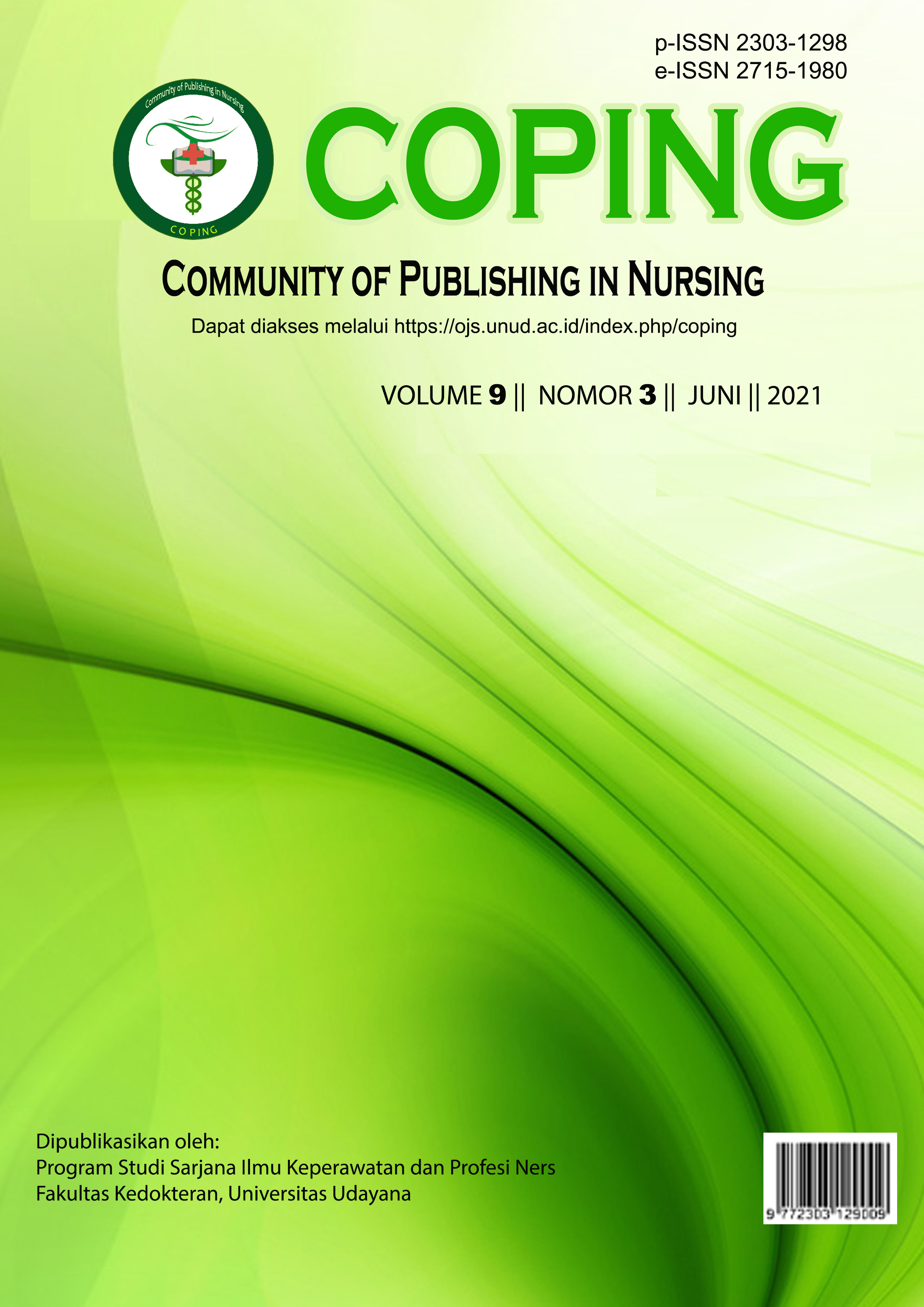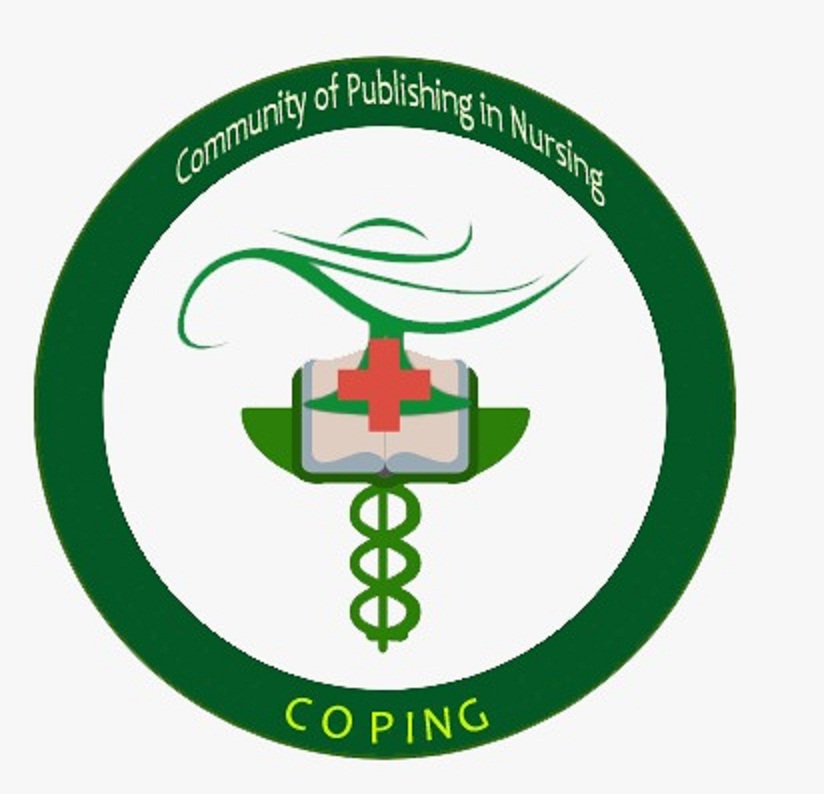GAMBARAN KEJADIAN LUKA BAKAR DAN TINGKAT PENGETAHUAN IBU TENTANG PERTOLONGAN PERTAMA LUKA BAKAR PADA ANAK USIA TODDLER DI DESA PADANGSAMBIAN KLOD
Abstract
Incidence of burns is a fairly common occurrence in toddler age, and mostly occur at home. Mothers who have close relationships with children have a very important role in providing physical, psychological and emotional protection for children. Action that mothers can give when child has a burn is giving first aid to prevent disability in children. This study aimed to describe the incidence of burns and knowledge level of mothers about first aid burns among toddlers in Padangsambian Klod Village. This research was a quantitative research methods with sample was 62 mothers. The sampling technique was probability sampling with a simple random sampling method. Data on the incidence of burns and knowledge level of mothers were collected using a questionnaire that compiled by the researchers. The result shows that the respondents in age 26-35 years were 42 people and last education were high school or equivalent were 31 people. Meanwhile, children in age range of 2 - 3 years with the number of 31 respondent for each boy and girls. Percentage of burn incidents in this study was 3.2% and knowledge level of mothers was in the sufficient category. Some mothers have a missunderstanding of first aid burns because they consider ice cubes, ice water compresses, and toothpaste to be used to heal wounds. Further researchers are expected to be able to increase the number of samples and develop a questionnaire so they can assess more about the incidence of burns and knowledge level of mothers about first aid.
Downloads
References
American Academy of Dermatology. (2017). How to treat a first-degree, minor burns. Retrieved from : https://www.aad.org/public/skin-hairnails/injured-skin/burns
American Burn Association. (2017). Scald injury prevention educators’s guide. Retrieved from : http://ameriburn.org/wpcontent/uploads/2017/04/scaldinjuryeduc atorsguide.pdf
American College of Emergency Physicians. (2014). First aid manual 5 th edition. US : Dorling Kindersley Limited
Asosiasi Penyelenggara Jasa Internet Indonesia. (2018). Potret zaman now : pengguna & perilaku internet Indonesia. Buletin APJII Ed. 23 – April 2018.
British Red Cross. (2018). First aid learning for young people. Retrieved from : https://www.redcross.org.uk/getinvolved/teaching-resources/first-aidlearning-for-young-people
Cahyaningrum, E.D. (2018). Keterpaparan informasi dengan tingkat pengetahuan ibu tentang penanganan demam pada anak. Jurnal Kesehatan Al-Irsyad, 11(2), 37 – 44. Retrieved from : http://download.garuda.ristekdikti.go.id
Ceka, A & Murati, R. (2016). The role of parents in the education of children. Journal of Education and Practice, Vol. 7 No. 5, p. 61 – 64
Davies, M., Maguire, S., Okolie, C., Watkins, W., & Kemp, A.M. (2013). How much do parents know about first aid for burns?. Journal of The International Society for Burn Injuries, 39, 1083 – 1090. Emma. (2018). First aid training – why it is so vital to learn. Retrieved from : https://firstaidforlife.org.uk/first-aidtraining-why-it-is-so-vital/
Gezova, K.C. (2015). Father’s and mother’s roles and their particularities in raising children. Acta Technologica Dubnicae, 5(1), 45 – 50.
IDAI. (2015). Pertolongan pertama pada luka bakar ringan – sedang. Retrieved from : www.idai.or.id/artikel/seputar-kesehatananak/pertolongan-pertama-pada-lukabakar-ringan-sedang
International Federation of Red Cross and Red Crescent Societies. (2016). International first aid and resuscitation guidelinemars 2016. Retrieved from : http://www.ifrc.org/Global/Publications/ Health/First-Aid-2016- Guidelines_EN.pdf
Johns Hopkins Medicine. (2018). Burns in Children. Retrieved from : https://www.hopkinsmedicine.org/health/ conditions-and-diseases/burns/burns-inchildren
Kattan, A. E., Alshomer, F., Alhujayri, A. K., Addar, A. & Aljerian, A. (2016). Current knowledge of burn injury first aid practices and applied traditional remedies : a nation survey. Burns and Trauma, 4(37), 1 – 7.
Kidshealth. (2015). Burns for parents. Retrieved from : https://kidshealth.org/en/parents/burns.ht ml Kids Health Info. (2018). Burns – prevention and first aid. Retrieved from : https://www.rch.org.au/kidsinfo/fact_she ets/Burns_prevention_and_first_aid/
Klossner, N.J & Hatfield, N.T. (2010). Introductory maternity & pediatric nursing. USA. Lippincott Williams & Wilkins. Klossner, N.J & Hatfield, N.T. (2010). Introductory maternity & pediatric nursing. USA. Lippincott Williams & Wilkins
McLeod, S. (2018). Jean Piaget’s theory of cognitive development. Retrieved from : https://www.simplypsychology.org/piage t.html
Murthy, M.S & Mathias, E. (2017). Review pediatric thermal burns and treatment : a review of progress and future prospects. Medicines MDPI, Vol. 4 (91),p. 1 – 11.
Notoatmodjo. (2012). Promosi kesehatan dan perilaku kesehatan. Jakarta : Rineka Cipta. Palang Merah Indonesia. (2008). Pertolongan pertama palang merah remaja tingkat wira. Jakarta : Bidang Penguatan Sumber Daya PMR dan Relawan.
Ricci, S.S & Kyle, T. (2009). Maternity and pediatric nursing. Philadelphia : Lippincott Williams Wilkins.
Riskesdas. (2013). Riset kesehatan dasar. Jakarta : Badan Penelitian dan Pengembangan Kesehatan Kemenkes RI. Safitri, Y.T. (2016). Hubungan tingkat pengetahuan orang tua dengan perilaku penggunaan first aid kit dalam penanganan cedera anak usia toddler di rumah tangga. Retrieved from : http://repository.umy.ac.id/bitstream/han dle/123456789/7315/Naskah%20Publika si.pdf?sequence=12&isAllowed=y
Sahril, N.B., Sien, Y.P., Mutalip, M.H., & Naidu, B.B. Home Injuries among Young Children in Malaysia : A Population Based Study. Clinics in Mother and Child Health, 11(2), 1 – 5
Sanyang, E., Peek-Asa, C., Young, T & Fuortes, l. (2017). Child supervision and burn outcome among admitted patients at major trauma hospitals in the Gambia. International Journal of Environmental Research and Public Health, 14, 1 – 10.
Sarabahi, S. (2010). Principles and practice of burn care. India : Jaypee Brothers Medical Publisher. Shroff, A. (2017). Piaget stages of development. Retrieved from : https://www.webmd.com/children/piagetstages-of-development#2-5
Sousa, D. (2010). Psychological aspects of paediatric burns (a clinical review). Annals of Burns and Fire Disasters, 23(3), 155 – 159. Sozen, I., Guldogan, C.E., & Yasti, A.C. (2015). Etiology of childhood burns and parental awareness in Turkey. Turkish Journal of Surgery, 32(3), 168 – 172.
Walsh, K., Nikkhah, D. & Dheansa, B. (2013). Burn scar contractures & their management. Plastic & Reconstructive Surgery. WHO. (2008). World report on child injury prevention. UNICEF : Switzerland. WHO. (2018). Burns. Retrieved from : https://www.who.int/news-room/factsheets/detail/burns
Wood, F.M., Phillips, M., Jovic, T., Cassidy, J.T., Cameron, P. & Edgar, D.W. (2016). Water first aid is beneficial in human post-burn : evidence from a bi-national cohort study. PLOS ONE, 1 – 13.
Zhai, H., Liu, S., Jiang, L., Sun, B., & Xin, S. (2014). Characteristics of 985 pediatric burns patients in the South of Liaoning Province of China. Burns & Trauma, 2(3), 136 – 140.







